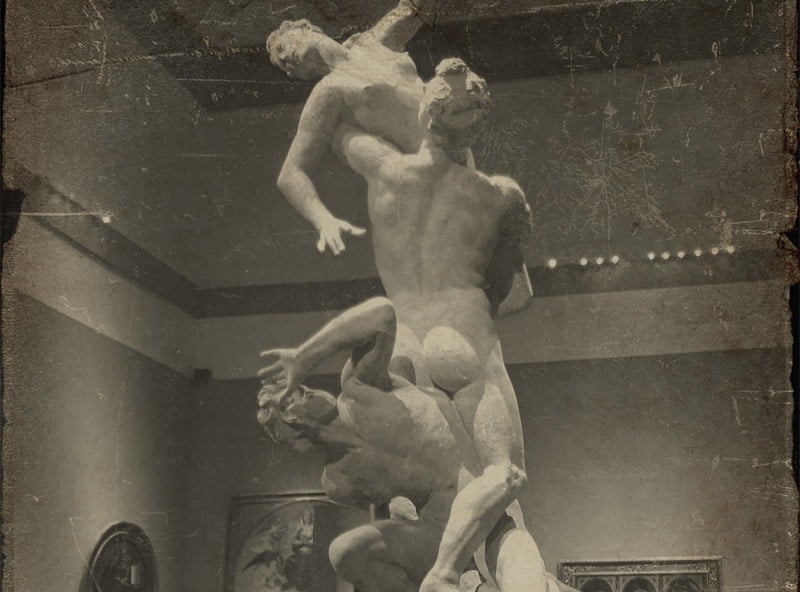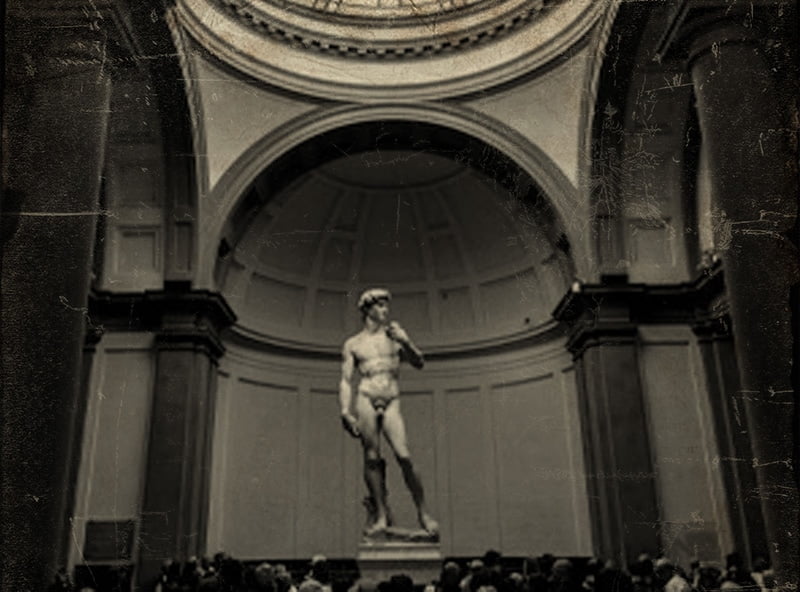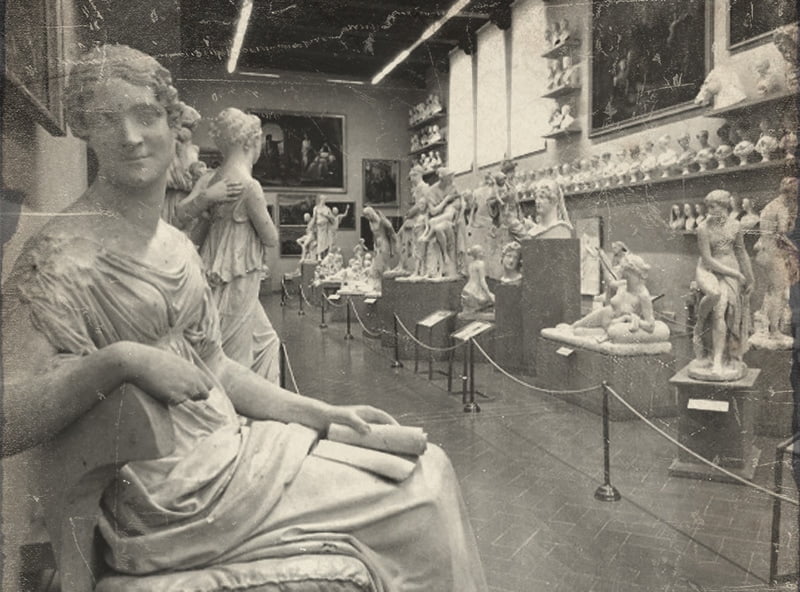Accademia Gallery Florence (La Galleria dell’Accademia di Firenze)
Florence’s Accademia Gallery, home to the world’s most beautiful statue
Visiting Florence is an endless journey into the timeless beauty of art, the kind of art that the whole world envies and, unfortunately, we often forget to pay tribute to. What is carefully preserved in the Accademia Gallery of Florence is considered the highest expression of art created by man, making this museum a must-visit. So, let’s learn about one of the most beautiful things to see in Florence: the Accademia Gallery and its precious treasure admired every year by thousands of tourists worldwide.
What to see in Florence: the Accademia Gallery
Florence is a city that exudes art, admired and loved worldwide. Every corner hides a palace or a historic dwelling, an invaluable piece of art that most people might not even notice. The Accademia Gallery is a corner of artistic paradise, not as well-known as the Uffizi Gallery or Palazzo Pitti, but equally deserving of a visit, if only for one of the world’s most famous sculptures it holds. Which one? If you have not guessed from the cover photo, keep reading to find out and organize your visit to Florence and the Accademia Gallery!

History of the Accademia Gallery Florence
Just as children are born, this Gallery was born in a hospital. In 1784, the rooms of what was once the San Matteo Hospital (and partly the San Niccolò di Cafaggio Convent) in Florence were converted into the headquarters of the Accademia di Belle Arti on the decision of Grand Duke Pietro Leopoldo of Lorraine.
At that time, art students would come here to admire, copy, and draw inspiration from the most famous contemporary and past artists’ works, both originals and reproductions. As time passed and the fame and prestige of the Accademia grew, the number of exhibited works also increased. However, some of these works were stolen during the French occupation (from 1798 to 1815) and never fully recovered.
Only two years after Napoleon’s presence, the Accademia Gallery Florence started acquiring works again, especially modern ones, thus combining Renaissance and Mannerist classics with modern and contemporary art, both paintings and sculptures. When Florence became the capital of Italy from 1865 to 1871, 146 works were added. From that moment on, the Accademia Gallery became one of the main points of reference for modern and contemporary art, and its prominence was further accentuated the following year (1872) when it started housing Michelangelo’s David.



A dedicated space was created for David, designed to showcase the sculpture with lighting works and repositioning of other artworks and structural changes to the building. Thanks to this renovation, seeing the incredible sculpture from a 360-degree perspective is now possible. However, it is slightly lower than the original, which partially loses the intended perspective effect originally designed by Michelangelo.
Modifications continued at the beginning of the 20th century, changing the arrangement of ancient paintings, now adequately supported to be admired and divided into different rooms for centuries.
In the 1920s, some works were distributed among Palazzo Pitti, the Gallery of Modern Art, the Uffizi, and the San Marco Museum. In recent years, many works have been relocated, requalified, and brought back to their former splendour, placing them in central positions in an effort of rediscovery and revaluation, trying to follow a common thread. Today, we see the result of an artistic and organizational journey that lasted more than three centuries.
Florence: what to see at the Accademia Gallery Florence?
Although Michelangelo’s David is undoubtedly the main attraction of the entire Accademia Gallery, it’s not the only thing to see in Florence. Inside, you can find some of the most beautiful works, especially from the Renaissance, including:
- Coronation of the Virgin, Jacopo di Cione (1325-1399), depicting the coronation with the patron saints of Florence in the background, combining religious and civic spirit.
- Christ in Pietà, Giovanni da Milano (1365), tempera and oil on panel depicting John the Evangelist and the Madonna next to the lifeless body of Christ, anticipating the subsequent Gothic style.
- Adimari Chest, Lo Scheggia (1450), a panel originally part of a wedding chest, depicting a wedding in Piazza del Duomo in Florence.
- The Thebaid , Paolo Uccello (1460), depicts multiple spiritual meditation episodes through prayer and penance.
- Tree of Life, Pacino di Bonaguida, depicts a complex tree-shaped cross which, according to the Apocalypse, represents Salvation and offers gifts to humankind.
- The Slaves, Michelangelo (1519-1534), a sculptural work displaying the “Young Slave,” the “Awakening Slave,” the “Bearded Slave,” and “Atlas,” four unfinished but incredibly vivid nudes.
- Venus and Cupid, Michelangelo Buonarroti (1533), depicts Venus kissing Cupid, representing the volatility of feelings.
- Rape of the Sabine Women, Giambologna (1574-1580), another sculptural group made from a single block of marble.
- Virgin and child with the young st john the baptist and two angels, Sandro Botticelli (1468-1470), with Mary holding the Child in her arms. One angel looks at Mary, while the other looks directly at the viewer.
Accademia Gallery Highlights | Must-See Artworks
In the Accademia Gallery, visitors can see the works of some of the most famous artists in history, including Giambologna, Bartolini, and Michelangelo. It is recommended that you hire a private guide for your visit to the Accademia Gallery.

Coronation of the Virgin
Artist: Jacopo di Cione
Year: 1372
Location: The Orcagna Room

Palestrina Pieta
Artist: Michelangelo Buonarroti
Year: 1550 – 1560
Location: Hall of Prisoners

The Adimari Chest
Artist: Lo Scheggia
Year: 1450
Location: Hall of the Colossus

The Thebaid
Artist: Paolo Uccello
Year: 1460
Location: Hall of Colossus

Venus and Cupid
Artist: Michelangelo
Year: 1533
Location: The Orcagna Room

The Slaves, Michelangelo
Artist: Michelangelo
Year: 1520
Location: Hall of Prisoners

Tree of Life
Artist: Pacino di Bonaguida
Year: 1310 – 1315
Location: 13th and Early 14th-century Room

Rape of the Sabine Women
Artist: Giambologna
Year: 1582
Location: Hall of Colossus

Virgin and child
Artist: Sandro Botticelli
Year: 1468
Location: The Orcagna Room
Michelangelo’s David: Everything You Need to Know
The “masterpiece” that attracts tourists from every corner of the world is undoubtedly Michelangelo’s David, of which we find a copy in Piazza della Signoria. This marble sculpture stands 5.20 meters tall, including the original base of 108 centimetres, and was sculpted by Michelangelo Buonarroti between 1501 and 1504, giving a face to the city and all of Italy.
This sculpture symbolizes the Renaissance and the world’s most beautiful artistic work ever created, embodying all principles of beauty, harmony, and perfection. The statue was commissioned to Michelangelo by the consuls of the Arte della Lana and the Opera del Duomo of Florence. It was initially intended to be placed outside the Cathedral of Santa Maria del Fiore.
However, Michelangelo was not the first choice: two other artists had already attempted the task but had abandoned it due to difficulties and problems related to the marble. The raw material was indeed too fragile, of poor quality, not compact enough, brittle, too tall, and too narrow to create a human figure.
Only the genius and skill of Michelangelo could accomplish the task, working in secret behind wooden boards to prevent curious onlookers from peeking while he was at work. After careful sculpting and stuccoing, which, for technical reasons, excluded the head of the opponent Goliath, during the celebration in honour of the city’s patron, Saint John, on June 23, 1503, the public saw the masterpiece for the first time, almost completed.



Only in May 1504 was the statue brought to its definitive location, a buttress of the Church of Santa Maria del Fiore dome, where Michelangelo had the opportunity to work for another three years.
However, the grandeur of the work made people think that another location was more appropriate, one where such perfection could be displayed and linked to a symbolism strongly tied to the politics of the time.
The debate on the new location of Michelangelo’s David involved illustrious personalities: Leonardo da Vinci, Botticelli, Antonio and Giuliano da Sangallo, Filippino Lippi, Pietro Perugino, and many others. After a long discussion, it was decided to place it in front of Palazzo Vecchio.
It took forty men, careful precautions, and four full days to transport David, but this did not prevent a small crowd of supporters of the Medici family from throwing stones in protest. Michelangelo’s statue, combined with the chosen position, represented an important political message supporting the republic. Even the direction in which David was looking, southwest, had a symbolic meaning: the challenge to Florence’s enemies.
The artwork suffered several damages due to weather factors (including a lightning strike) and social factors (riots, upheavals, and even vandalism). In the late 1800s, it was decided to move it to the Tribune in the Gallery of Antique Paintings at the Accademia Gallery. Since 1910, we can admire the copy made by Luigi Arrighetti in Piazza della Signoria.
Accademia gallery florence guided tours

Skip-the-Line Guided Tour of Accademia Gallery
Semi-Private Tour Max 6 People
Tour Duration: 1.5 hour
Skip the ticket line
€ 35.39

Accademia and Uffizi Semi-Private Tour (6 people)
Semi-Private Tour Max 6 People
Tour Duration: 4 hours
Skip the ticket line
€82.51
Accademia Gallery Florence : Tickets, How to Get There, and Opening Hours
First, it’s important to mention that the Accademia Gallery in Florence is located at Via Ricasoli, 58-60, not far from the Cathedral of Santa Maria del Fiore and the Basilica of Santa Maria Novella. You can easily walk there from Santa Maria Novella train station. If you prefer public transportation, the nearest bus stop is for lines 1 or 17, just a short walk from Santa Maria Novella Station.
Accademia Gallery Florence : Tickets and Prices
Regarding the Accademia Gallery Florence, tickets can be purchased both online and on-site. Of course, buying them in advance online is advisable to avoid the queue at the authorized retailer’s website. If you intend to buy tickets on-site, remember that the ticket office closes half an hour before the closing time (6:15 PM).
Regarding the prices:
Full ticket: €13
Reduced ticket (for young people aged 18-25): €3
Free entry for all categories listed at this link
To book your ticket (mandatory reservation for Saturdays and Sundays), you can call +39 055 294883. The reservation has an additional cost of €4.00.
Accademia Gallery Florence: Opening Hours and Map
The Accademia Gallery, like most museums in the city, is closed on Mondays, as well as on January 1 and December 25.
You can visit it from Tuesday to Sunday, from 8:15 AM to 6:50 PM, with the last entry at 6:20 PM. However, if you plan a weekend in Florence, remember that a reservation is mandatory to visit the Gallery on Saturdays and Sundays.
Free entrance on the first sunday of the month
The Accademia Gallery is offering free entry on the first sunday of every month starting on April 3rd, 2022.
Helpful Information about the Accademia Gallery Florence
Inside the Accademia Gallery in Florence, you will find the world’s most extensive collection of Michelangelo’s works.
Guided tours are available, but currently, due to Covid-19 safety reasons, a maximum of 5 people can participate in addition to the guide.
Audio guides are available for 4 euros.
The visit to the Accademia Gallery includes several rooms, such as the Colosso Hall, the Prisoners Gallery, the Tribune (where the David is located), the Bartolini Gipsoteca, the Duecento and Trecento Hall, and the Museum of Musical Instruments.
How long does the visit take? Allow at least two hours to visit the Accademia Gallery.
On the ground floor, there is a bookshop where you can purchase books, publications, and souvenirs.
The Gallery is accessible to people with disabilities from Via Ricasoli, 60.
At the entrance, you will pass through a metal detector, during which potentially dangerous objects (knives, scissors, metallic objects, etc.) will be collected and stored near the metal detector.
There is no cloakroom, so entering with large bags, backpacks, helmets, etc, is impossible.
Similarly, food and drinks inside the museum are prohibited, except for water bottles up to half a litre.
The Lost items in the museum are handed over to the Lost and Found Office of the Municipality of Florence at Via Veracini on 5/5.
For any other information, you can go to the information desk at the entrance or contact the Accademia Gallery at +39 055 0987100, email ga-afi.info@beniculturali.it, or PEC mbac-ga-afi@mailcert.beniculturali.it.
Frequently Asked Questions About the Accademia Gallery Florence
What are some of the highlights at the Accademia Gallery?
You can Discover an array of captivating masterpieces at the Accademia Gallery in Florence. Marvel at renowned works such as Michelangelo’s David and Prisoners, Jacopo di Cione’s Coronation of the Virgin, Pacino di Bonaguida’s Tree of Life, Giambologna’s Rape of Sabines, Lo Scheggia’s Cassone Adimari, and Narco di Cione’s Trinity. Immerse yourself in the brilliance of Italian Renaissance art while exploring these iconic artworks.
How long does it take to see the highlights of the Accademia Gallery?
The duration to explore the Accademia Gallery’s highlights depends on your interests and the time spent admiring each artwork. On average, you can cover all the highlights in about 1-2 hours, allowing for a fulfilling and enriching experience of the gallery’s remarkable collection.
How many works of Michelangelo are on display at the museum?
Discover the world’s most extensive collection of Michelangelo’s masterpieces at the Accademia Gallery in Florence. Among the seven awe-inspiring works housed in this museum, you’ll find the renowned statue of David, showcasing the genius of the legendary artist.
How can I see the artworks at Accademia Gallery?
To access the remarkable collection at Accademia Gallery, tickets must be purchased. You can buy them in advance online or directly at the ticket office during your visit. We recommend taking a guided tour of the museum to get the most out of your visit.
Is the Accademia free first Sunday of the month?
Yes, Admission to the Accademia Gallery is free of charge on the first Sunday of every month.
What is the best day to visit Accademia Gallery?
For a more enjoyable experience, plan your visit to Accademia Gallery on weekdays when it’s less crowded. Exploring the gallery during morning hours allows for a tranquil experience. Opt for early mornings or late afternoons to avoid the heat and the crowds. Remember that weekends, particularly during peak tourist season, are busier.
Is there a dress code for Accademia Gallery?
While the Galleria dell’Accademia museum does not enforce a formal dress code, it’s advisable to dress modestly, especially if you visit cathedrals like the Duomo after your museum tour.
